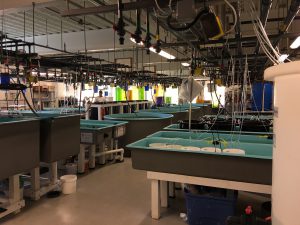A study supported by NCCOS and the NOAA Ocean Acidification Program found thatinteracting effects of acidified and low oxygen (hypoxic) waters reducedthe survival, growth, and development of larval stages of three important shellfish species: bay scallops, hard clams and eastern oysters. Shellfish larvae were exposed to ideal, acidified and low oxygen conditions both individually and in combination. The study included these treatments both as constant conditions and with fluctuations similar to an estuary.

In estuarine environments, water quality conditions can change rapidly due to tidal exchanges, high nutrient input from runoff, and daily temperature fluctuations and sunlight that fuels daily algal growth. This can have large impacts on oxygen and carbon dioxide (CO2) levels such asdecreased oxygen and increased acidity in the water that can interfere with shellfish growth. Even though oxygen and CO2 vary simultaneously in nature, they are seldom simulated fluctuating together in laboratory studies.
Continuously acidified conditions reduced survival of larvae of all 3 species, slowed growth of larval bay scallops and eastern oysters, and delayed the development of bay scallop larvae.Continuously hypoxic conditions reduced the survival, growth, and development of larval bay scallops and slowed the development of larval hard clams.The negative effects were even more pronounced when low oxygen and acidified water were combined than for each factor separately.
When conditions alternated between ideal and low oxygen/acidified on a daily basis, the negative effects of low oxygen and/or acidification remained, even though the conditions were more favorable for part of the daily cycle.
This suggests that the fluctuations were too intense, and/or the durations of more favorable conditions were too short for bivalve larvae to overcome the stress of low oxygen and acidification. All of these negative impacts could ultimately impact shellfish industries, as well as the many ecosystems services that bivalves provide.
For more information, contact Elizabeth.Turner@noaa.gov.
